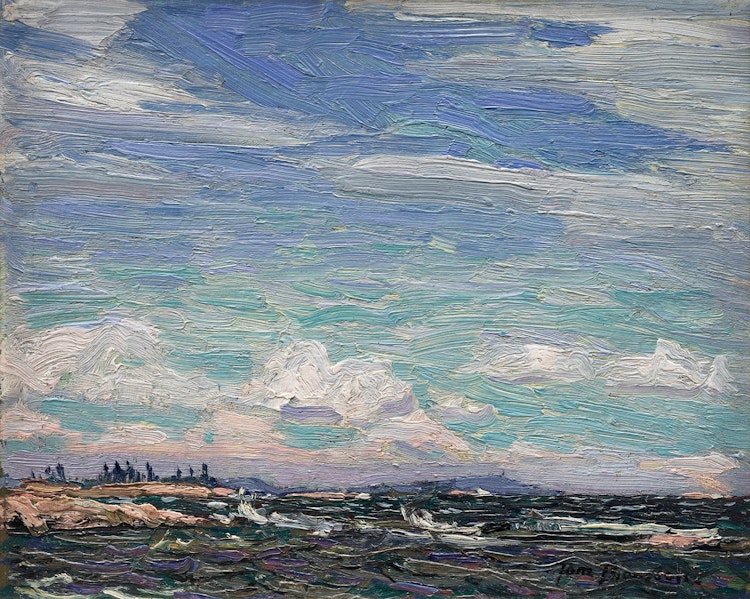Giant's Tomb, Georgian Bay, Summer 1914 by Tom Thomson

Tom Thomson
Giant's Tomb, Georgian Bay, Summer 1914
oil on composite wood-pulp board
signed lower right; catalogue raisonné no. 1914.23
8.5 x 10.5 in ( 21.6 x 26.7 cm )
Auction Estimate: $500,000.00 - $700,000.00
Price Realized $888,000.00
Sale date: November 27th 2024
Dr. James MacCallum, Toronto, 1914
Wedding Gift to Mr. and Mrs. George Lawton Ridout, 15 September 1914
Gift to Mrs. McColl, Chattanooga, Tennessee
Sotheby's, auction, Toronto, 18 November 1992, lot 72
Private Collection, Toronto
Private Collection
"Tom Thomson: North Star", McMichael Canadian Art Collection, Kleinburg, Ontario, 24 June 2023-12 January 2024
'Capt. W. Ridout Dies in Malaya', "Globe & Mail", https://www.veterans.gc.ca/en/remembrance/memorials/canadian-virtual-war-memorial/detail/2142725
Tom Thomson to F. H. Varley, postmarked July 8, 1914. The Thomson Collection (PC-936), quoted in Joan Murray, 'Tom Thomson’s Letters' in Dennis Reid and Charles C. Hill, "Tom Thomson", Toronto/Ottawa, 2002, page 298
Charles C. Hill, 'Tom Thomson: Painter' in Dennis Reid and Charles C. Hill, "Tom Thomson", Toronto/Ottawa, 2002, page 125
Joan Murray, "Tom Thomson Catalogue Raisonné" (2016): https://www.tomthomsoncatalogue.org/catalogue/index.php, no. 1914.23
Sarah Milroy and Ian. A.C. Dejardin, "Tom Thomson: North Star", Kleinburg, Ontario, 2023, reproduced page 66
Thomson painted the view at three different times – at dawn, dusk, and here, at mid-day. He was transfixed by the overarching sky, the fast water, the sparse trees of the distant island, and the far distant Giant’s Tomb Island, which from where he looked could hardly be seen. The slight indication of distant view seemed magical to him.
He had essayed the subject of skies previously in sketches he had brought down to Toronto from Canoe Lake in Algonquin Park in the fall of 1913 so likely it was a fellow worker at Grip Ltd. that year who told him of their potential to add veracity to a scene. J.E.H. MacDonald, Thomson’s boss and mentor, is the main candidate for this advice. English-born, he worked in England at a top design studio from 1903 to 1907, and would have known of the great John Constable and his many sketches in which the English artist accurately observed clouds and weather conditions. While working at Grip, MacDonald had painted a series of cloud studies and if he and Thomson talked about painting clouds, they would have agreed whole-heartedly that skies were a keynote of landscape painting.
Or the idea of painting skyscapes may have come from Arthur Lismer, another ‘Brit’, and co-worker at Grip who camped with Thomson in May of 1914 about when Thomson began to paint skies in earnest. Or Thomson may have been encouraged to paint skies due to his success with selling cloud pictures. In 1914, the National Gallery of Canada bought his canvas of "Moonlight, Early Evening".
Thomson painted "Giant’s Tomb, Georgian Bay", not in Algonquin Park but in a subsequent locale to which he travelled in 1914, Georgian Bay. He arrived there by train in early June at the invitation of Dr. MacCallum who was keen to show him the landscape and camped with the doctor at French River, then journeyed with him to MacCallum’s cottage at Go-Home Bay and painted sketches in the region.
Early in August, having found cottage life too gentrified for his taste (it had a ‘birthday cake and water ice’ atmosphere he wrote F. H. Varley), he paddled and portaged by canoe back to his base at Mowat Lodge in Algonquin Park, where he was joined by A.Y. Jackson. There the joint journey began that resulted in the founding of the Group of Seven in 1920.
Skies painted in Algonquin Park and then Georgian Bay were a prelude for Thomson but an important one. Afterwards, he developed many sketches of transient skies and sky phenomena, sunsets and sunrises, thunderclouds, even lightning. It was a theme he explored at length. At the same time, he felt increasingly confident of his medium, bolder, and his work shows it.
He probably gave the sketch to MacCallum who treasured it, giving it as a gift to Dr. G. Lawton Ridout of Toronto and his wife Dorothy on their wedding day, September 15th, 1914. Dr. Ridout must have gone overseas shortly afterwards – he served as a major with the Royal Fusiliers in the First World War, returning to Canada in 1919. MacCallum would have been moved by his young friend’s bravery in signing up for active service in the armed forces and given him a wedding gift that meant much to MacCallum personally and also spoke compellingly - and cheerfully, MacCallum would have felt - of the beauties of Canada.
Long afterwards, the painting was given as a gift to a Mrs. McColl of Chattanooga, Tennessee, then it was featured in Sotheby’s Auction in Toronto on the 18th of November 1992 lot 72 of “Important Canadian Art”. From there, it was treasured in a private collection in Toronto. "Giant’s Tomb, Georgian Bay" has always been a favourite, bespeaking summer skies and fine weather of a popular vacation spot for hardy outdoors adventurers in Canada painted by a Canadian master.
We extend our thanks to Joan Murray, Canadian art historian, for contributing the preceding essay. Joan, the Director Emerita of the Robert McLaughlin Gallery in Oshawa, has written many books on Tom Thomson and published the "Tom Thomson Catalogue Raisonné".
Share this item with your friends
Tom Thomson
(1877 - 1917)
Tom Thomson was born near Claremont, Ontario and grew up in Leith, near Owen Sound. After moving to Toronto, his early career was spent as a commercial artist at Grip Ltd., the commercial design firm where he first met MacDonald, Harris, Jackson, Lismer and others. By 1911, Thomson was making regular sketching trips to areas north of Toronto and, in 1912, he made the first of many trips to Algonquin Park.
As well as being an artist, Tom Thomson was an avid outdoorsman and Algonquin Park soon became his favourite place to paint. His enthusiasm for its quiet, untouched landscape with its changing moods and bright fall colours inspired other artists to explore the region. After 1914, Tom Thomson spent most of his time painting in Algonquin, except during the coldest winter months. It was during this period that he produced the bulk of his paintings of this rugged northern landscape. Thomson's brief, but prolific, career as an artist came to a premature end when he drowned in Canoe Lake in 1917, just three years before the Group of Seven held their first exhibition. His artistic achievement was to remain an inspirational force to other Group members.

